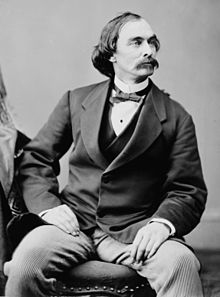Isaac Israel Hayes
Isaac Israel Hayes (born March 5, 1832 in Chester County , Pennsylvania , † December 17, 1881 in New York ) was an American doctor and polar explorer .
Kane's 2nd Grinnell Expedition (1853 to 1855)
Immediately after completing his studies at the University of Pennsylvania (1853) he took part in the search for the missing John Franklin and his men by working as a ship's doctor on the expedition financed by Henry Grinnell and led by Elisha Kent Kane (so-called 2. Grinnell Expedition ). The search was unsuccessful - like all other of the numerous expeditions started to rescue Franklin in the middle of the 19th century - but contributed significantly to the exploration of the Canadian and Greenland Arctic .
Starting from the Kane Basin , which the expedition chose as winter quarters, Kane and Hayes each undertook separate sleigh rides to the north . Hayes explored the northern part of Ellesmere Island , while his partner Kane explored northern Greenland ( Washingtonland and the Humboldt Glacier ).
The two of them encountered ice-free zones in the Arctic Ocean and thus came up with a theory that sparked the imagination of numerous adventurers and polar explorers in the years that followed: Hayes assumed that the constant drift of the ice floes would lead to one across the frozen Kane Basin the ice-free, navigable zone of the Arctic Ocean would allow expeditions to advance to the North Pole relatively easily . In 1855 the expedition returned to Upernavik .
Hayes' search for the ice-free Arctic Ocean
Five years later, Hayes started a new Arctic expedition , inspired by the then popular theory of the ice-free Arctic Ocean and obsessed with the goal of finding this ice-free, navigable zone of the Arctic Ocean around the North Pole. The expedition was born under an unlucky star: Hayes had intended to only in Greenland sled dogs to stock, a 1859 furious there rabies epidemic had but the Husky backlog drastically reduced. In addition, one of Hayes' companions died in Upernavik , one of the two crew members who had already experienced the Arctic.
The primary goal was to advance as far north as possible in the first year in order to be able to reach the supposed ice-free zone in the following year. Bad weather prevented the United States , Hayes' ship, from reaching at least the Kane Basin, so the winter quarters were set up at the westernmost point of Greenland, Cape Alexander not far from today's Etah settlement on the peninsula named after Hayes.
Because two thirds of the sled dogs died of an epidemic in the winter of 1860/61 , Hayes was forced to send back his astronomer August Sonntag , accompanied by Inuk Hans Hendrik , to get new dogs. During this action, Sunday had an accident, so that Hayes was now the last member of his crew to have Arctic experience.
In the spring, Hayes set off north with the new dogs, on May 19, 1861, after a 46-day sleigh ride, he reached the northernmost point of this expedition, Lady Franklin Bay at 81 ° 35 ′ north latitude. From there, Hayes saw the Kennedy Canal , which he found ice-free and believed to be the entrance to the open, navigable Arctic Sea.
Hayes last arctic voyage
Back in " civilization ", Hayes was confronted with political problems: the American Civil War prevented another expedition. He was only able to set out for North Greenland again in 1869, this time traveling exclusively with Inuit, living with them and adopting their customs. The greatest success of Hayes' last expedition was the discovery of the Robeson Canal in 1871, which belied his own theory that the Kennedy Canal would lead directly into the Arctic Ocean.
effect
Hayes 'discovery successes were quickly surpassed by subsequent expeditions, his theory of the ice-free Arctic Ocean was clearly refuted in the following years, but Hayes' travelogues are particularly interesting for posterity, which still stimulate the imagination due to the vivid descriptions.
Works
- An Arctic Boat Journey . (1860), about the expedition with Kane.
- The Open Polar Sea . (1867), about his expedition 1859–1861.
- The Land of Desolation . (1871)
Honors
In addition to the aforementioned Hayes Peninsula in northwestern Greenland also are Heiss Island in the archipelago Franz Josef Land and Glacier Hayesbreen on the island of Spitsbergen named after him. In 1863 he was elected a member of the American Philosophical Society .
literature
- Fergus Fleming : Ninety degrees north. The Dream of the Pole , Piper, 2004, ISBN 3-492-24205-7 .
Web links
Individual evidence
- ^ Member History: Isaac I. Hayes. American Philosophical Society, accessed September 25, 2018 .
| personal data | |
|---|---|
| SURNAME | Hayes, Isaac Israel |
| BRIEF DESCRIPTION | American doctor and polar explorer |
| DATE OF BIRTH | March 5, 1832 |
| PLACE OF BIRTH | Chester County , Pennsylvania |
| DATE OF DEATH | December 17, 1881 |
| Place of death | new York |
